Fracture Identification Using Conventional Logs in Ultra-Low Permeability Sandstone Reservoirs: A Case Study of the Chang 6 Member of the Ordos Basin, China
Abstract
1. Introduction
2. Geological Setting
3. Methods
3.1. Logging Curve Normalization
3.2. Reconstructing Curves for Curve Change Rate
3.3. Fracture Indicator Curve
4. Results
4.1. Natural Fracture Characteristics
4.1.1. Fracture Angle
4.1.2. Fracture Density
4.1.3. Fracture Orientation
4.1.4. Effectiveness of Fractures
4.2. Influencing Factors for Fracture Development
4.3. Fracture Identification Using Conventional Logs
5. Discussion
6. Conclusions
Author Contributions
Funding
Data Availability Statement
Acknowledgments
Conflicts of Interest
References
- Li, G.; Zhu, R. Progress, challenges and key issues of unconventional oil and gas development of CNPC. China Pet. Explor. 2020, 25, 1–13. [Google Scholar]
- Zou, C.; Yang, Z.; Zhu, R.; Zhang, G.; Hou, L.; Wu, S.; Tao, S.; Yuan, X.; Dong, D.; Wang, Y.; et al. Progress in China’s unconventional oil & gas exploration and development and theoretical technologies. Acta Geol. Sinica 2015, 89, 979–1007. [Google Scholar]
- Law, J.B.; Curtis, J.B. Introduction to unconventional petroleum systems. AAPG Bull. 2002, 86, 1851–1852. [Google Scholar]
- Liu, K.; Wang, R.; Shi, W.; Travé, A.; Martín-Martín, J.D.; Baqués, V.; Qi, R.; Lin, J.; Ye, H. Diagenetic controls on reservoir quality and heterogeneity of the Triassic Chang 8 tight sandstones in the Binchang area (Ordos Basin, China). Mar. Pet. Geol. 2022, 146, 105974. [Google Scholar] [CrossRef]
- Ameen, M.; MacPherson, K.; Al-Marhoon, M.; Rahim, Z. Diverse fracture properties and their impact on performance in conventional and tight-gas reservoirs, Saudi Arabia: The Unayzah, South Haradh case study. AAPG Bull. 2012, 96, 459–492. [Google Scholar] [CrossRef]
- Xiao, L.; Li, J.; Mao, Z.; Yu, H. A method to evaluate pore structures of fractured tight sandstone reservoirs using borehole electrical image logging. AAPG Bull. 2020, 103, 205–226. [Google Scholar] [CrossRef]
- Zeng, L.; Su, H.; Xiaomei, T.; Peng, Y.; Gong, L. Fractured tight sandstone oil and gas reservoirs: A new play type in the Dongpu depression, Bohai Bay Basin, China. AAPG Bull. 2013, 97, 363–377. [Google Scholar] [CrossRef]
- Li, Y.; Shang, Y.; Yang, P. Modeling fracture connectivity in naturally fractured reservoirs: A case study in the Yanchang Formation, Ordos Basin, China. Fuel 2018, 211, 789–796. [Google Scholar] [CrossRef]
- Sava, D.; Mavko, G. Rock physics-based integration of geologic and geophysical data for fracture characterization. Lead. Edge 2007, 26, 1140. [Google Scholar] [CrossRef]
- Zeng, L.; Xiang-Yang, L. Fractures in sandstone reservoirs with ultra-low permeability: A case study of the Upper Triassic Yanchang Formation in the Ordos Basin, China. AAPG Bull. 2009, 93, 461–477. [Google Scholar] [CrossRef]
- Zhou, X.; Cao, C.; Yuan, J. The research actuality and major progresses on the quantitative forecast of reservoir fractures and hydrocarbon migration law. Adv. Earth Sci. 2003, 18, 398–404. [Google Scholar]
- Luo, Q. Core Observation and Description of Tight Sandstone Fractured Reservoir. Xinjiang Pet. Geol. 2010, 31, 229–231. [Google Scholar]
- Chatterjee, R.; Datta Gupta, S.; Mandal, P. Fracture and stress orientation from borehole image logs: A case study from Cambay basin, India. J. Geol. Soc. India 2017, 89, 573–580. [Google Scholar] [CrossRef]
- Dias, L.O.; Bom, C.R.; Faria, E.L.; Valentín, M.B.; Correia, M.D.; de Albuquerque, M.P.; de Albuquerque, M.P.; Coelho, J.M. Automatic detection of fractures and breakouts patterns in acoustic borehole image logs using fast-region convolutional neural networks. J. Pet. Sci. Eng. 2020, 191, 107099. [Google Scholar] [CrossRef]
- Lyu, W.; Zeng, L.; Li, Z.; Liu, G.; Zu, K. Fracture responses of conventional logs in tight-oil sandstones: A case study of the Upper Triassic Yanchang Formation in southwest Ordos Basin, China. AAPG Bull. 2016, 100, 1399–1417. [Google Scholar] [CrossRef]
- Bhattacharya, S.; Mishra, S. Applications of machine learning for facies and fracture prediction using Bayesian Network Theory and Random Forest: Case studies from the Appalachian basin, USA. J. Pet. Sci. Eng. 2018, 170, 1005–1017. [Google Scholar] [CrossRef]
- Ja’fari, A.; Kadkhodaie-Ilkhchi, A.; Sharghi, Y.; Ghanavati, K. Fracture density estimation from petrophysical log data using the adaptive neuro-fuzzy inference system. J. Geophys. Eng. 2012, 9, 105–114. [Google Scholar] [CrossRef]
- Xue, Y.; Cheng, L.; Mou, J.; Zhao, W. A new fracture prediction method by combining genetic algorithm with neural network in low-permeability reservoirs. J. Pet. Sci. Eng. 2014, 121, 159–166. [Google Scholar] [CrossRef]
- Dong, S.; Zeng, L.; Lyu, W.; Xu, C.; Liu, J.; Mao, Z.; Tian, H.; Sun, F. Fracture identification by semi-supervised learning using conventional logs in tight sandstones of Ordos Basin, China. J. Nat. Gas Sci. Eng. 2020, 76, 103131. [Google Scholar] [CrossRef]
- Aghli, G.; Soleimani, B.; Moussavi-Harami, R.; Mohammadian, R. Fractured zones detection using conventional petrophysical logs by differentiation method and its correlation with image logs. J. Pet. Sci. Eng. 2016, 142, 152–162. [Google Scholar] [CrossRef]
- Shi, Y.; Xiao, L.; Mao, Z.; Guo, H. An identification method for diagenetic facies with well logs and its geological significance in low-permeability sandstones: A case study on Chang 8 reservoirs in the Jiyuan region, Ordos Basin. Acta Pet. Sin. 2011, 32, 820–828. [Google Scholar]
- Yu, H.; Wang, Z.; Rezaee, R.; Zhang, Y.; Nwidee, L.N.; Liu, X.; Verrall, M.; Iglauer, S. Formation water geochemistry for carbonate reservoirs in Ordos basin, China: Implications for hydrocarbon preservation by machine learning. J. Pet. Sci. Eng. 2020, 185, 106673. [Google Scholar] [CrossRef]
- Jiang, Z.; Mao, Z.; Shi, Y.; Wang, D. Multifractal Characteristics and Classification of Tight Sandstone Reservoirs: A Case Study from the Triassic Yanchang Formation, Ordos Basin, China. Energies 2018, 11, 2242. [Google Scholar] [CrossRef]
- Yu, H.; Lebedev, M.; Zhou, J.; Lu, M.; Li, X.; Wang, Z.; Han, T.; Zhang, Y.; Johnson, L.M.; Iglauer, S. The rock mechanical properties of lacustrine shales: Argillaceous shales versus silty laminae shales. Mar. Pet. Geol. 2022, 141, 105707. [Google Scholar] [CrossRef]
- Qiao, J.; Zeng, J.; Jiang, S.; Wang, Y. Impacts of sedimentology and diagenesis on pore structure and reservoir quality in tight oil sandstone reservoirs: Implications for macroscopic and microscopic heterogeneities. Mar. Pet. Geol. 2020, 111, 279–300. [Google Scholar] [CrossRef]
- Bai, Y.; Zhao, J.; Wu, W. Methods to determine the upper limits of petrophysical properties in tight oil reservoirs: Examples from the Ordos and Songliao Basins. J. Pet. Sci. Eng. 2021, 196, 107983. [Google Scholar] [CrossRef]
- Fu, Y.; Luo, J.; Shi, X.; Cao, J.; Mao, Q.; Sheng, W. Implications of lithofacies and diagenetic evolution for reservoir quality: A case study of the Upper Triassic chang 6 tight sandstone, southeastern Ordos Basin, China. J. Pet. Sci. Eng. 2022, 218, 111051. [Google Scholar] [CrossRef]
- Liu, H.; Yang, Y.; Wang, F.; Deng, X.; Liu, Y.; Nan, J.; Wang, J.; Zhang, H. Micro pore and throat characteristics and origin of tight sandstone reservoirs: A case study of the Triassic Chang 6 and Chang 8 members in Longdong area, Ordos Basin, NW China. Petr. Explor. Dev. 2018, 45, 239–250. [Google Scholar] [CrossRef]
- Yang, S.; Bao, Z.; Wang, N.; Qu, X.; Lin, Y.; Shen, J.; Awan, R.S. Diagenetic evolution and its impact on reservoir quality of tight sandstones: A case study of the Triassic Chang 6 Member, Ordos Basin, northwest China. Mar. Pet. Geol. 2020, 117, 104360. [Google Scholar] [CrossRef]
- Dai, J.; Li, J.; Luo, X.; Zhang, W.; Hu, G.; Ma, C.; Guo, J.; Ge, S. Stable carbon isotope compositions and source rock geochemistry of the giant gas accumulations in the Ordos Basin, China. Org. Geochem. Adv. Nat. Gas Geochem. Chin. Sediment. Basins 2005, 36, 1617–1635. [Google Scholar] [CrossRef]
- Dang, B.; Zhao, H.; Li, W.H.; Yang, X.Q.; Dang, Y.C. Characteristic of sedimentary microfacies in Chang 6 oil-bearing Formation of Yanchang formation of Ansai oil field. Nat. Gas Geosci. 2004, 15, 587–600. [Google Scholar] [CrossRef]
- Jing, J.; Wei, W.; Mei, Z.; Li, Z. Method of well logging interpretation for fracture reservoirs of carbonate rock—A case study in Tahe oil field. Prog. Geophys. 2005, 20, 78–82. [Google Scholar]
- Sugimoto, T.; Yamamoto, Y.; Yamamoto, Y.; Lin, W. A Method for Core Reorientation Based on Rock Remanent Magnetization: Application to Hemipelagic Sedimentary Soft Rock. Mater. Trans. 2020, 61, 1638–1644. [Google Scholar] [CrossRef]
- Narr, W.; Lerche, I. A method for estimating subsurface fracture density in core. AAPG Bull. 1984, 68, 637–648. [Google Scholar]
- Narr, W. Fracture density in the deep subsurface: Techniques with application to Point Arguello oil field. AAPG Bull. 1991, 75, 1300–1323. [Google Scholar]
- Chen, S.; Lei, J.; Liu, C.; Yao, J.; Li, Y.; Li, S.; Su, K.; Xiao, Z. Factors controlling the reservoir accumulation of Triassic Chang 6 Member in Jiyuan-Wuqi area, Ordos Basin, NW China. Pet. Explor. Dev. 2019, 46, 253–264. [Google Scholar] [CrossRef]
- Xiao, Z.; Ding, W.; Liu, J.; Tian, M.; Yin, S.; Zhou, X.; Gu, Y. A fracture identification method for low-permeability sandstone based on R/S analysis and the finite difference method: A case study from the Chang 6 reservoir in Huaqing oilfield, Ordos Basin. J. Pet. Sci. Eng. 2019, 174, 1169–1178. [Google Scholar] [CrossRef]
- Zhang, Y.; Wei, S.; Shuwen, D. Changes of Late Mesozoic Tectonic Regimes around the Ordos Basin (North China) and their Geodynamic Implications. Acta Geol. Sin.-Engl. Ed. 2011, 85, 1254–1276. [Google Scholar] [CrossRef]
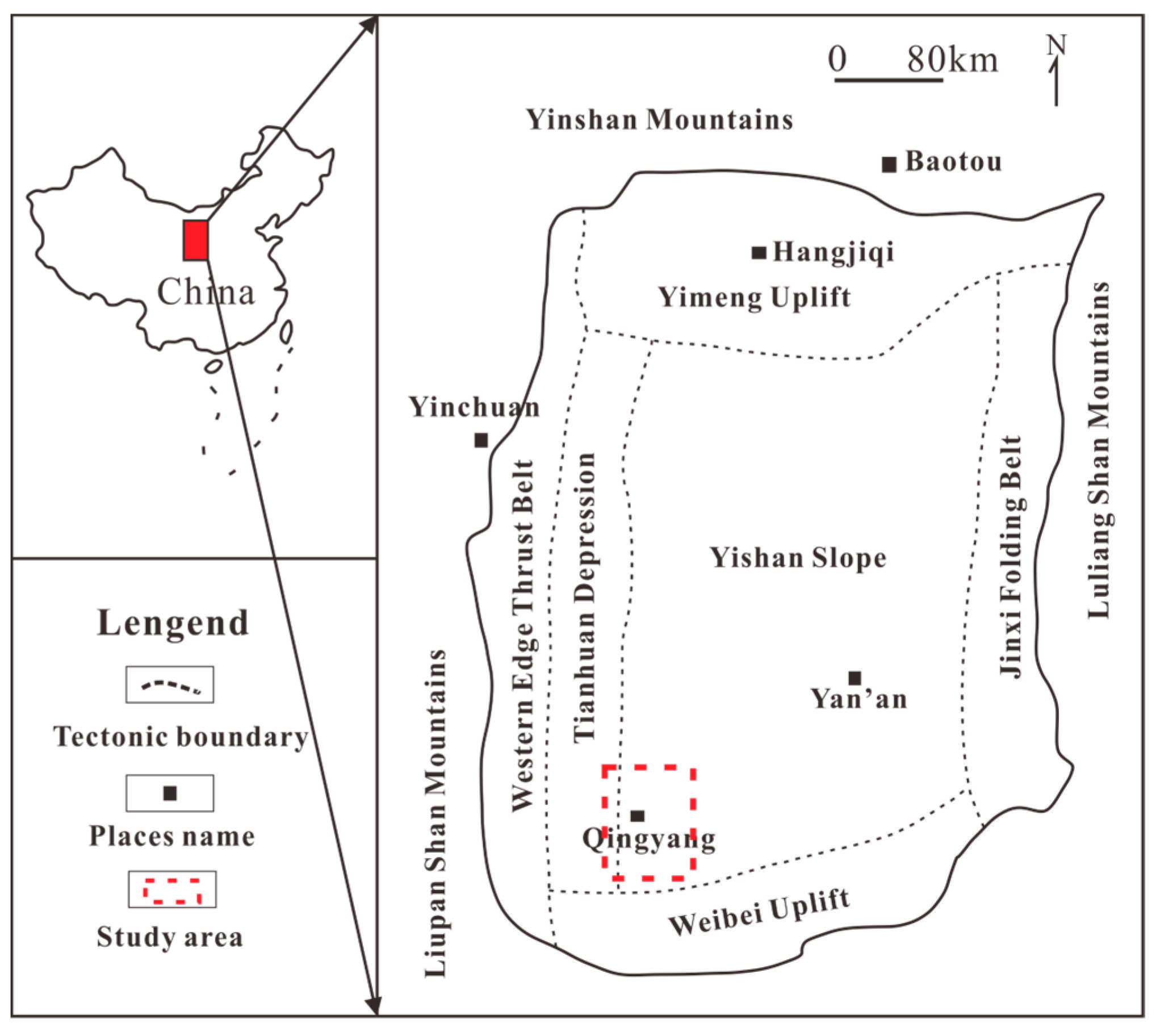
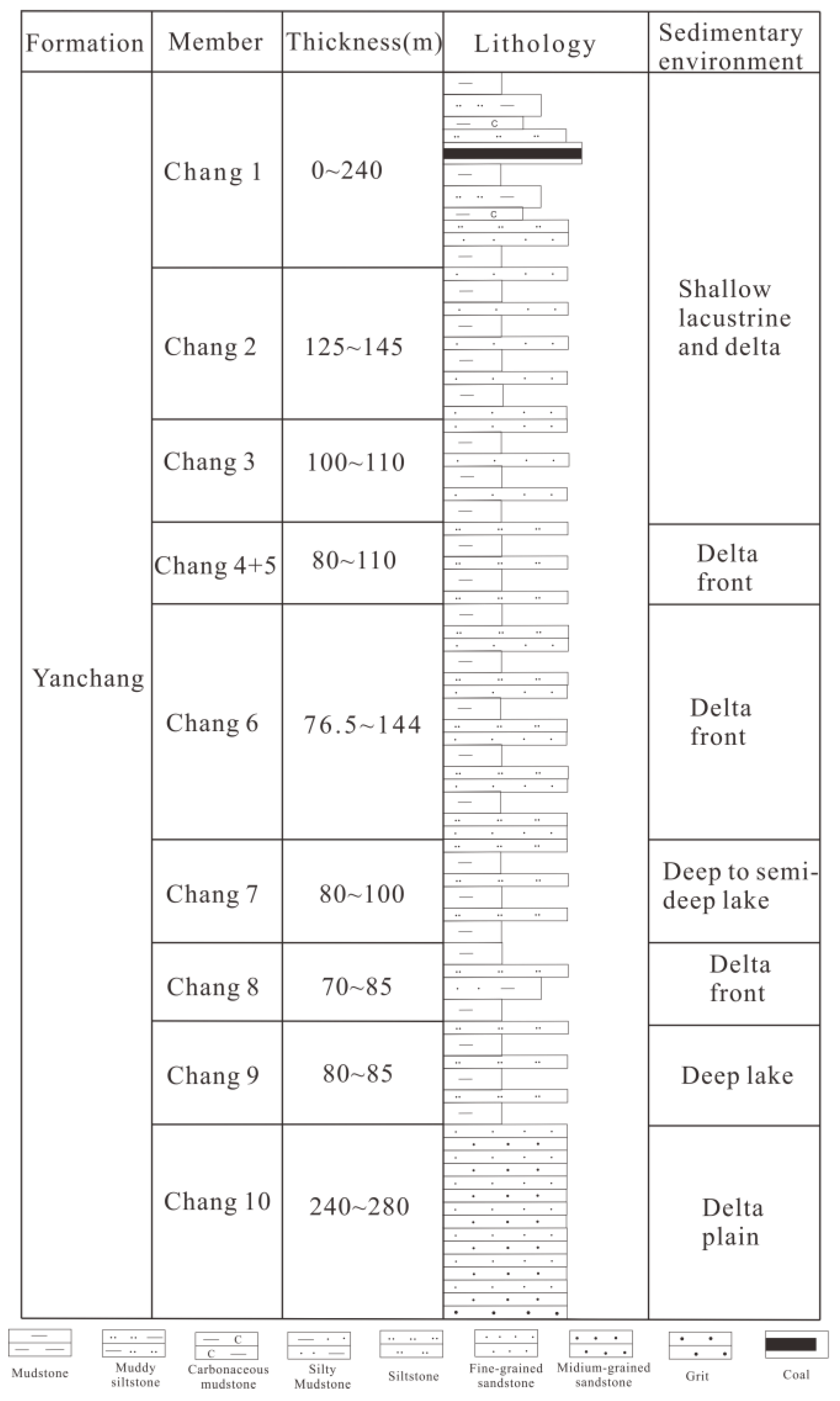


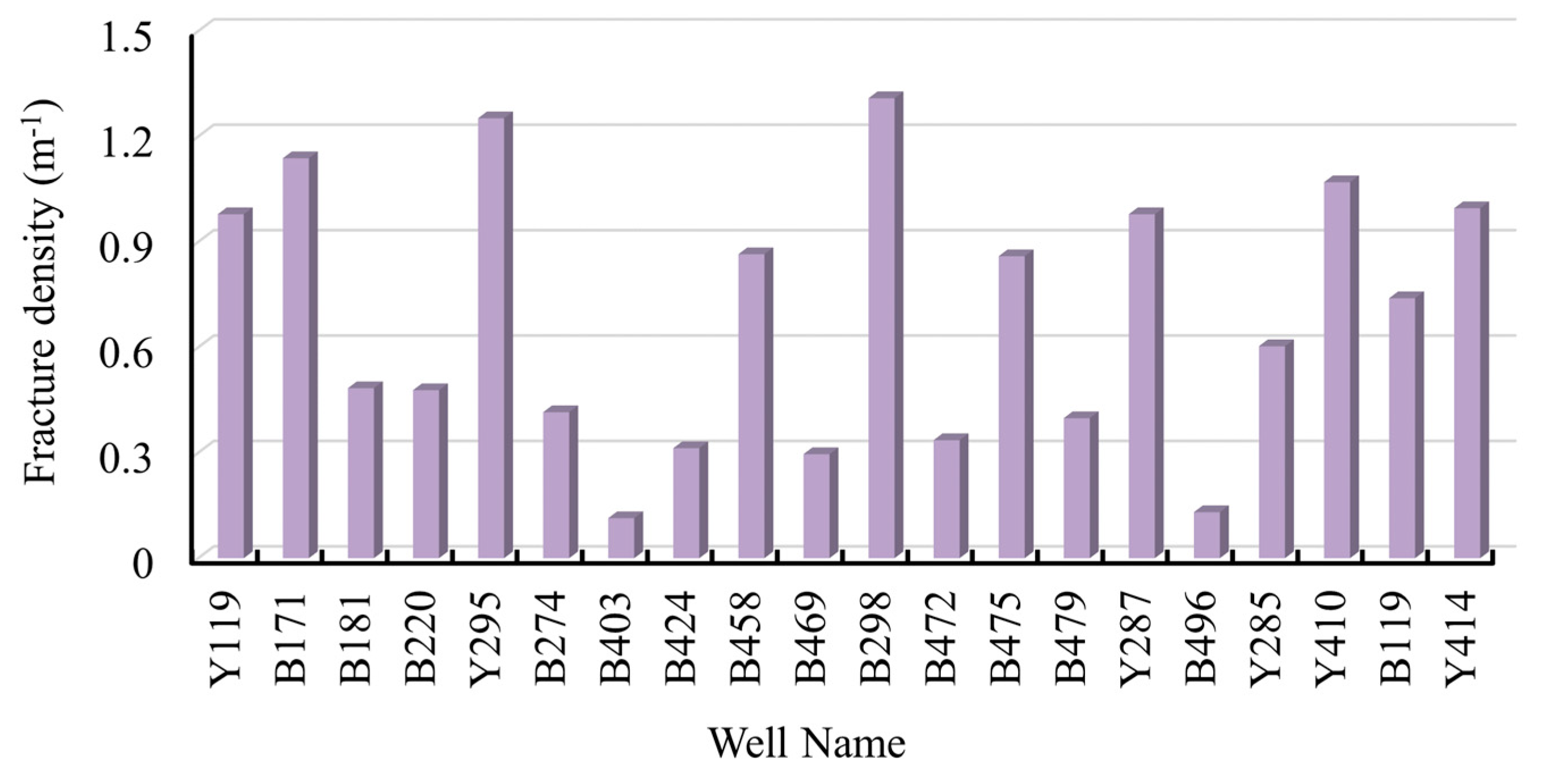

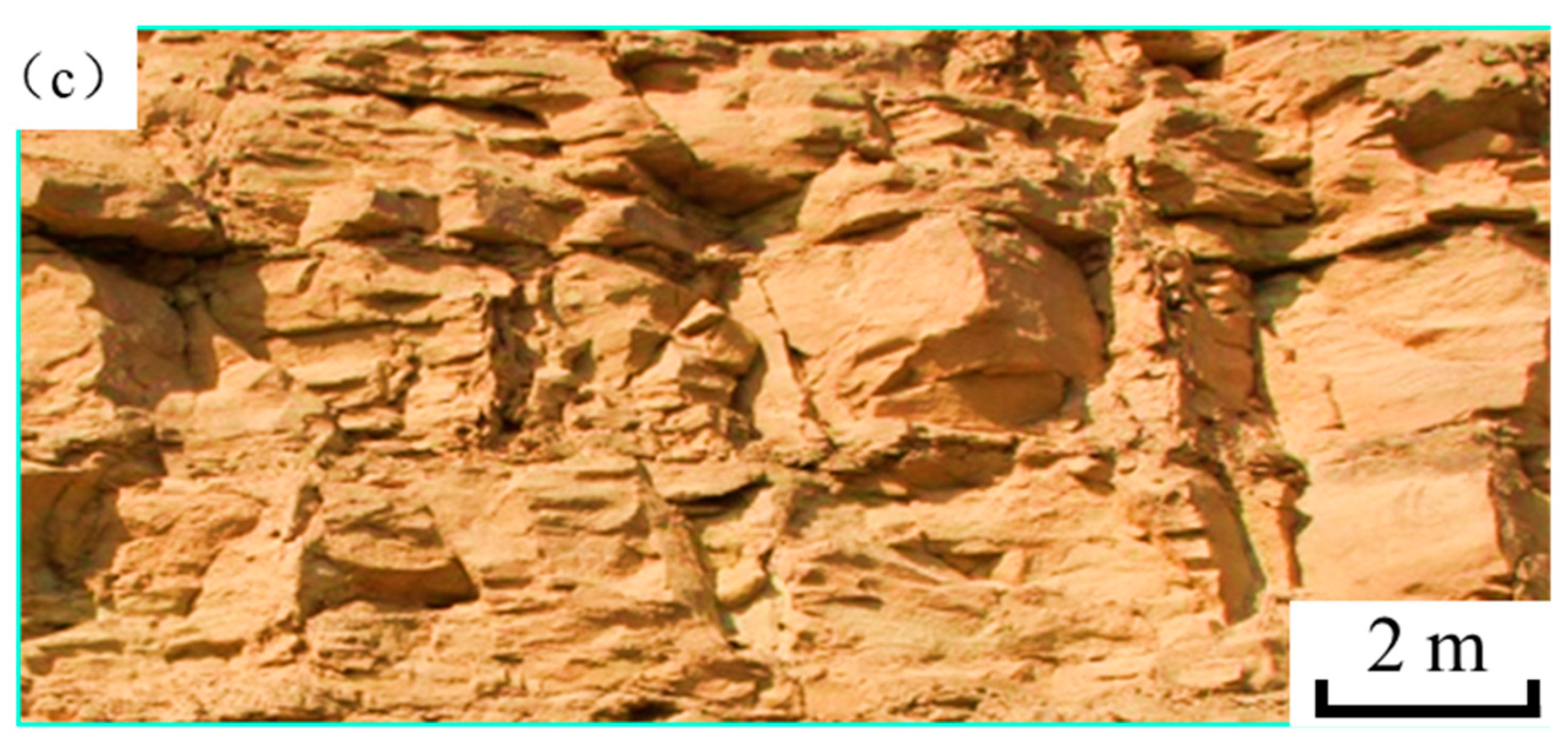
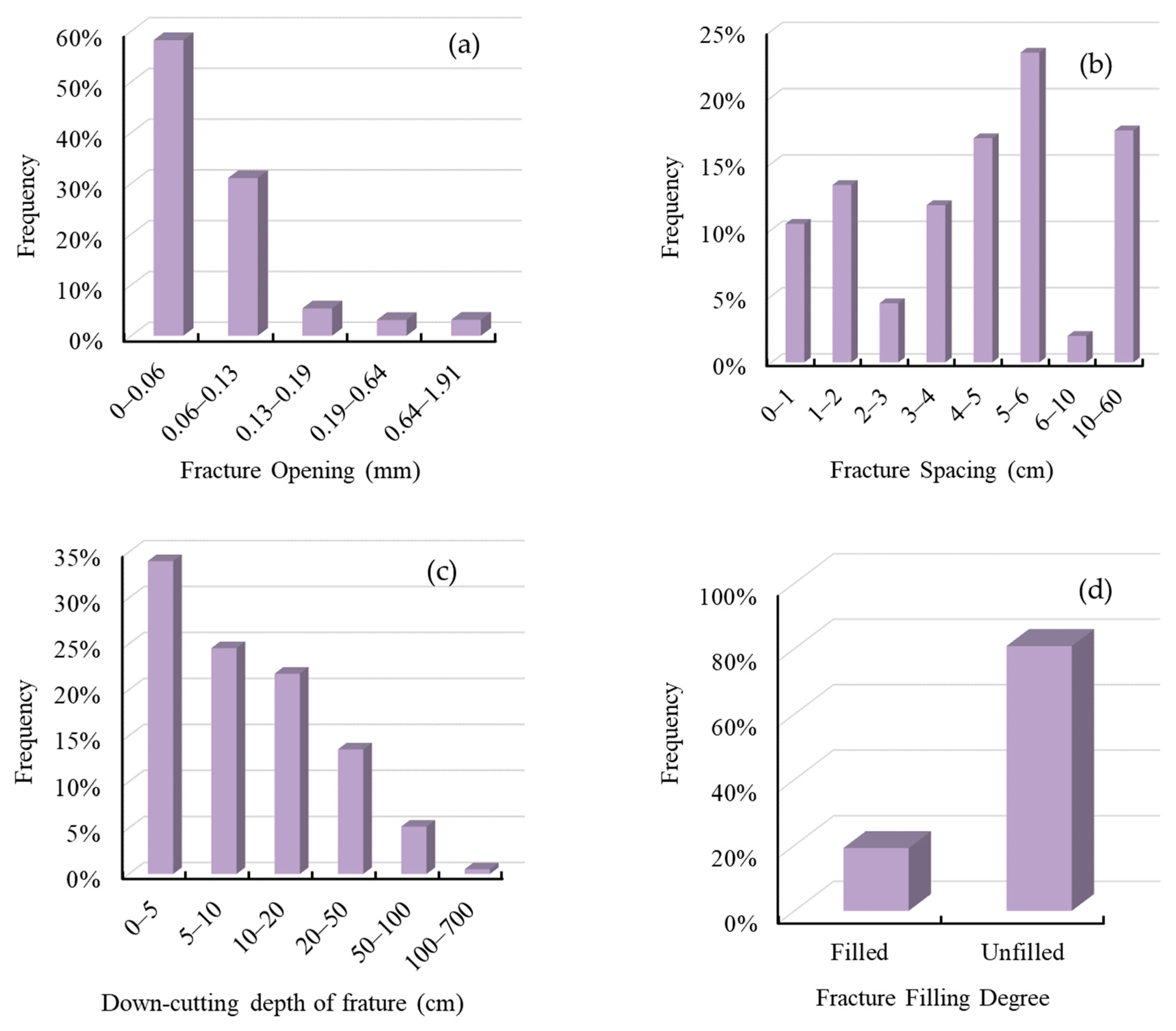

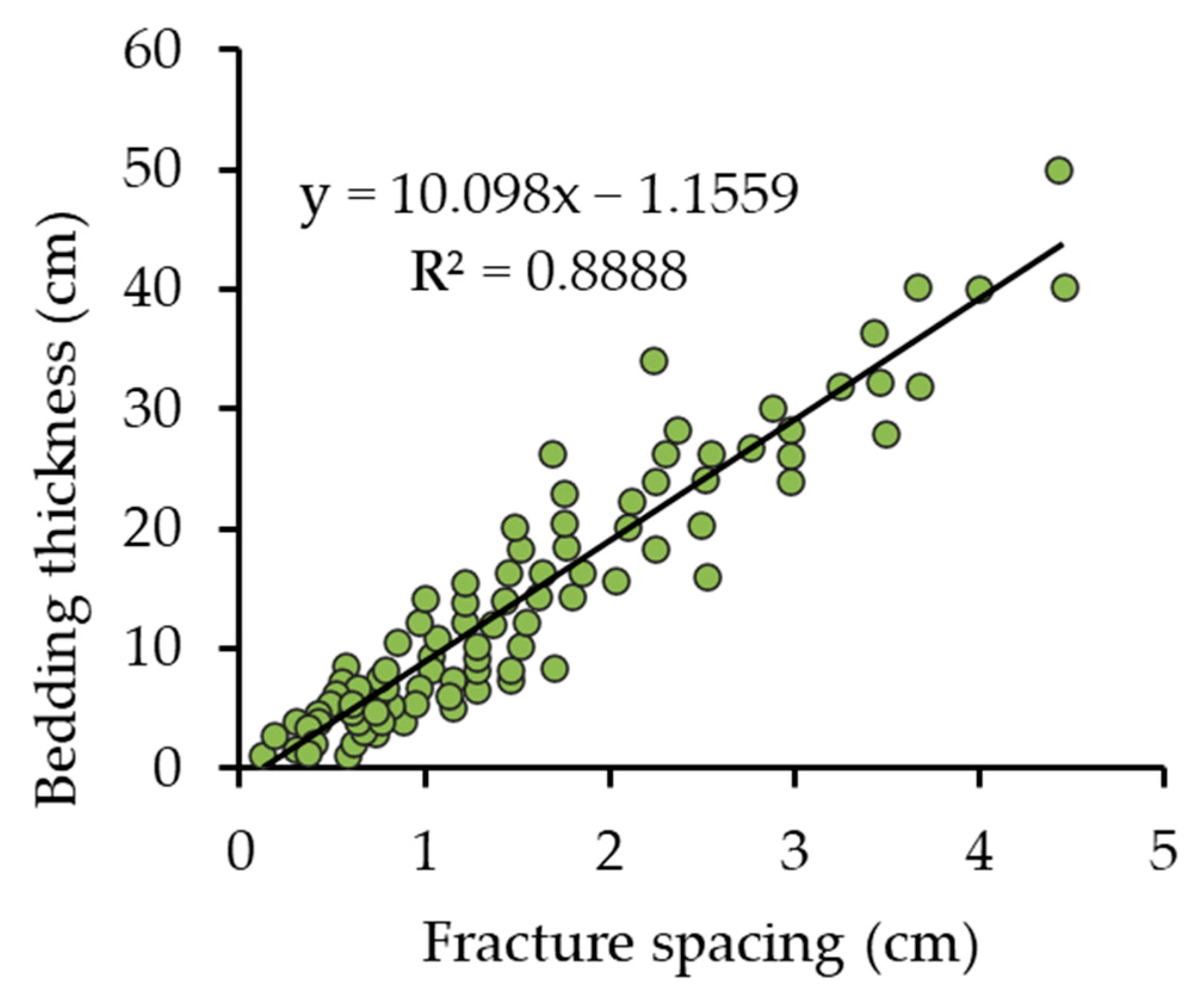
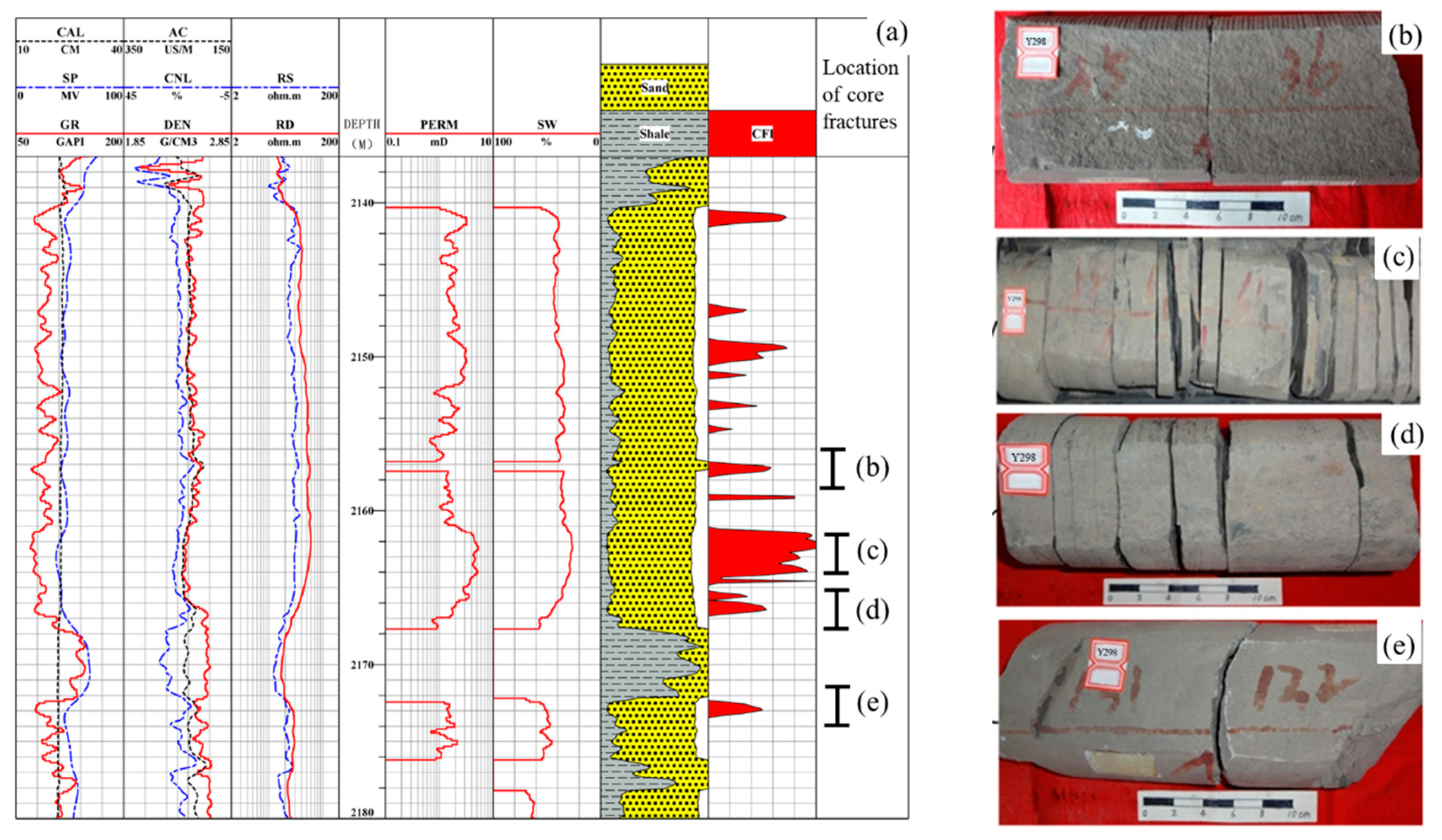
| Well Name | FGR | FAC | FRLLD | FRLLS | FCAL |
|---|---|---|---|---|---|
| Y119 | 0.502 | 0.837 | 0.713 | 0.825 | 0.342 |
| B171 | 0.482 | 0.804 | 0.904 | 0.828 | 0.322 |
| B181 | 0.443 | 0.739 | 0.865 | 0.738 | 0.283 |
| B220 | 0.490 | 0.817 | 0.840 | 0.796 | 0.330 |
| Y295 | 0.442 | 0.737 | 0.833 | 0.832 | 0.282 |
| B274 | 0.457 | 0.761 | 0.855 | 0.750 | 0.297 |
| B403 | 0.416 | 0.693 | 0.806 | 0.853 | 0.256 |
| B424 | 0.537 | 0.894 | 0.813 | 0.773 | 0.377 |
| B458 | 0.466 | 0.777 | 0.790 | 0.746 | 0.306 |
| B469 | 0.438 | 0.730 | 0.771 | 0.814 | 0.278 |
| B298 | 0.492 | 0.820 | 0.805 | 0.748 | 0.332 |
| B472 | 0.480 | 0.799 | 0.784 | 0.707 | 0.320 |
| B475 | 0.470 | 0.784 | 0.813 | 0.806 | 0.310 |
| B479 | 0.527 | 0.878 | 0.807 | 0.769 | 0.367 |
| Y287 | 0.481 | 0.801 | 0.730 | 0.729 | 0.321 |
| B496 | 0.434 | 0.724 | 0.808 | 0.833 | 0.274 |
| Y285 | 0.499 | 0.832 | 0.812 | 0.837 | 0.339 |
| Y410 | 0.536 | 0.893 | 0.786 | 0.711 | 0.376 |
| B119 | 0.458 | 0.763 | 0.814 | 0.842 | 0.298 |
| Y414 | 0.495 | 0.825 | 0.769 | 0.755 | 0.335 |
| Average | 0.477 | 0.795 | 0.806 | 0.785 | 0.317 |
Disclaimer/Publisher’s Note: The statements, opinions and data contained in all publications are solely those of the individual author(s) and contributor(s) and not of MDPI and/or the editor(s). MDPI and/or the editor(s) disclaim responsibility for any injury to people or property resulting from any ideas, methods, instructions or products referred to in the content. |
© 2023 by the authors. Licensee MDPI, Basel, Switzerland. This article is an open access article distributed under the terms and conditions of the Creative Commons Attribution (CC BY) license (https://creativecommons.org/licenses/by/4.0/).
Share and Cite
He, S.; Meng, K.; Wang, C.; Chen, Y.; Zhao, H.; Wang, H.; Yu, H. Fracture Identification Using Conventional Logs in Ultra-Low Permeability Sandstone Reservoirs: A Case Study of the Chang 6 Member of the Ordos Basin, China. Minerals 2023, 13, 297. https://doi.org/10.3390/min13020297
He S, Meng K, Wang C, Chen Y, Zhao H, Wang H, Yu H. Fracture Identification Using Conventional Logs in Ultra-Low Permeability Sandstone Reservoirs: A Case Study of the Chang 6 Member of the Ordos Basin, China. Minerals. 2023; 13(2):297. https://doi.org/10.3390/min13020297
Chicago/Turabian StyleHe, Shanbin, Kun Meng, Ce Wang, Yingbo Chen, Hao Zhao, Haoyuan Wang, and Hongyan Yu. 2023. "Fracture Identification Using Conventional Logs in Ultra-Low Permeability Sandstone Reservoirs: A Case Study of the Chang 6 Member of the Ordos Basin, China" Minerals 13, no. 2: 297. https://doi.org/10.3390/min13020297
APA StyleHe, S., Meng, K., Wang, C., Chen, Y., Zhao, H., Wang, H., & Yu, H. (2023). Fracture Identification Using Conventional Logs in Ultra-Low Permeability Sandstone Reservoirs: A Case Study of the Chang 6 Member of the Ordos Basin, China. Minerals, 13(2), 297. https://doi.org/10.3390/min13020297










